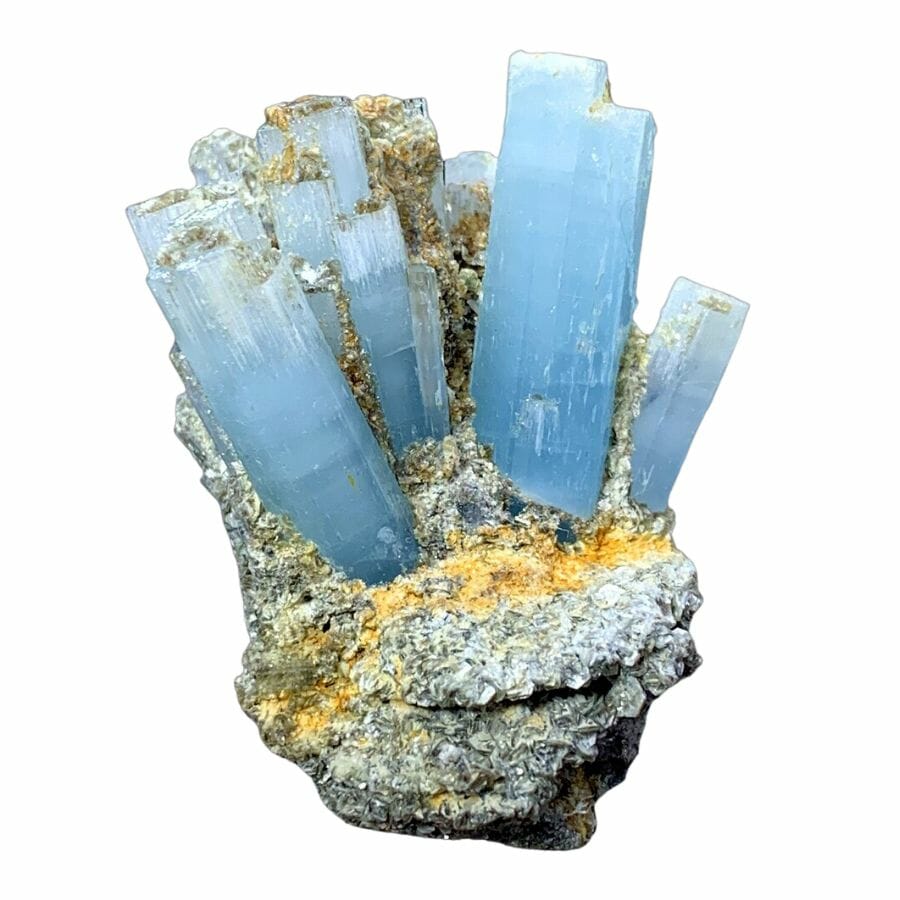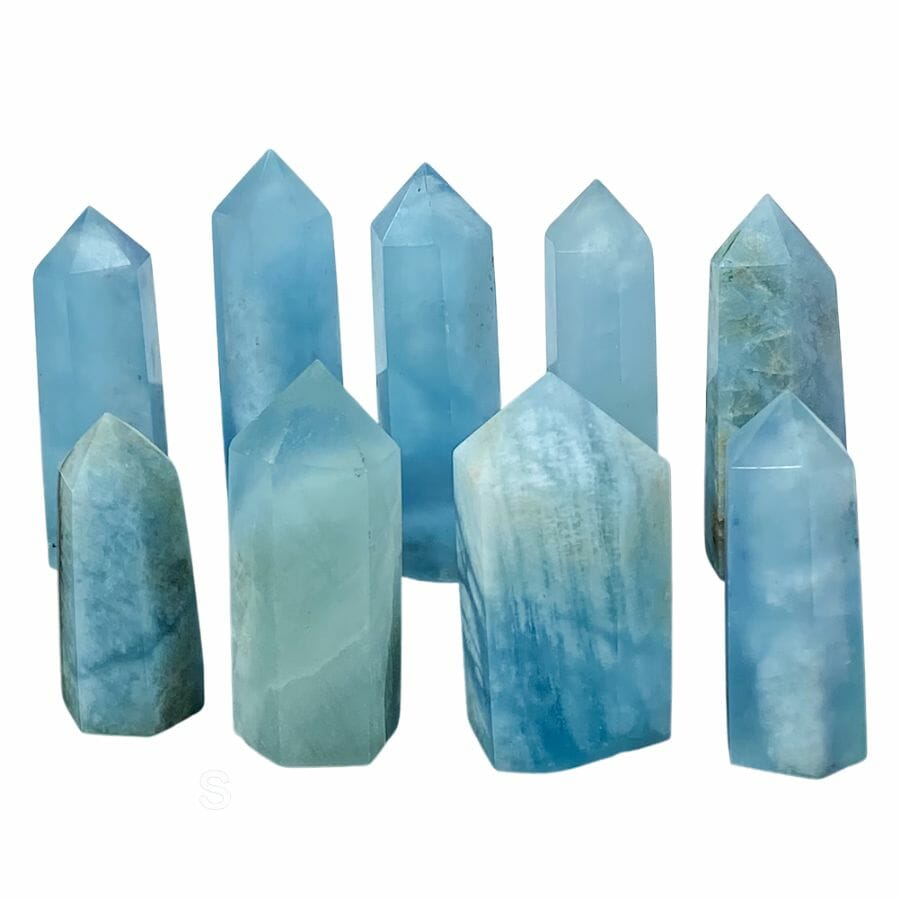When you see aquamarine, the first thing that may come to mind is its beauty, making it a favorite for jewelry pieces. But besides its beauty, what is aquamarine good for?
This gem has been used in various practical applications, from optical instruments to detailed carvings. If you’re considering buying aquamarine or simply curious about its uses, it’s essential to know its real-world applications.
Additionally, understanding its characteristics can help distinguish genuine aquamarine from imitations. Knowing more about aquamarine can help those looking to buy, own, or identify this captivating gem.
Understanding Aquamarine Its Origins

Aquamarine is part of the beryl family of gems. It forms deep inside the Earth when molten rock cools, and minerals start to crystallize. Over time, these crystals grow into larger formations that we recognize as gemstones.
The first thing you’ll notice about aquamarine is its color. It can range from light blue to a deep green-blue, depending on the amount of iron in it.
People have found aquamarine in many places around the world, including Brazil, Africa, and the United States.
In the past, sailors wore aquamarine jewelry, believing it would keep them safe at sea. It has also been a popular choice for rings, necklaces, and other adornments.
Besides jewelry, aquamarine has uses in carving and in some optical tools. It’s a gem with a rich history and a wide range of applications.
The meaning of aquamarine
The word “aquamarine” comes from two Latin words: “aqua,” which means water, and “marina,” which means sea. When you put them together, you get “sea water.”
This name perfectly describes the gem’s beautiful blue and green-blue shades, reminding many of the ocean’s colors. For ages, this gem has been cherished for its stunning hues, and its name gives a nod to the deep blue seas.
What Aquamarine Is Good For And Used For
Beyond its eye-catching appearance, aquamarine has real-world applications that many might find surprising. From its role in optical tools to intricate art pieces, this gemstone boasts a range of practical uses.
Navigating the world of rocks and minerals can be exciting but tricky. Dive into our guide on how to identify your rock, and don’t miss the tips on finding and identifying aquamarine.
Jewelry

Aquamarine shines brilliantly when transformed into jewelry. With its captivating color and impressive durability, it’s easy to understand its popularity among jewelers and consumers alike.
The gem’s hardness, ranging from 7.5 to 8 on the Mohs scale, ensures that it can endure frequent wear, making it perfect for items like rings or bracelets that might face frequent friction.
When people consider what aquamarine is worth, they not only think of its monetary value but also its timeless beauty and the elegance it adds to any jewelry collection.
Collecting

In the world of rock collecting, aquamarine stands out for several reasons. Mineral enthusiasts often seek it out for its unique color and clarity.
High-quality specimens, particularly those that are large and transparent, are quite the prize for collectors. Some of these pieces have striking features like well-defined crystal shapes or rare inclusions.
Adding aquamarine benefits a collection by offering variety and a touch of natural beauty. Collectors know that the best specimens elevate their collection but also serve as a testament to nature’s ability to create awe-inspiring treasures.
Typically, collectors value aquamarine for its aesthetic appeal, and it often becomes a centerpiece in their displays.
Carvings and Art

Aquamarine has long been appreciated not just for its beauty but also for its qualities that make it a favorite among artists and craftsmen.
The hardness of aquamarine stands up well to carving and it has a clarity that lets light shine through. Because of this, aquamarine becomes a canvas for intricate designs and detailed figures.
Artists have used aquamarine to craft everything from small statues to ornate jewelry pieces.
The gem’s ability to capture and reflect light enhances the depth and detail of the carvings, making them pop and come to life. Its cool blue tone also adds an element of serenity to artwork.
Gemological Education

In the realm of gemological studies, aquamarine holds a notable position. So what does aquamarine do in gemology? This gem provides a perfect specimen to delve into various aspects of gemstone study.
Its clear blue tones allow for easy examination of inclusions or internal features, while its unique optical characteristics offer insights into light interactions.
By analyzing its refractive index, one can learn about how light bends when passing through different materials. Additionally, its hardness and crystal structure give hands-on experience in understanding gemstone durability and formation.
Unproven Aquamarine Benefits And Additional Uses
Beyond the undeniable beauty and scientific significance of aquamarine, many people are drawn to its rumored spiritual qualities. While these beliefs haven’t been proven by science, they have deep roots in various cultures and traditions.
Over the years, aquamarine has been associated with numerous myths and legends. Exploring these spiritual tales offers a deeper understanding of the gem’s cultural significance and the ways people connect with it on a personal level.
We are about to discuss some of the claimed metaphysical and healing properties of X. It is important to know that there is no scientific evidence or studies that support any of these claims in any way.
All studies and research that have been conducted on the healing and metaphysical properties of X and other crystals have shown that study participants report the same perceived benefits whether they are given real or fake X.
Any alleged success in healing or other benefits is believed to be either falsely attributed to X exposure or a result of the placebo effect. There has not been a single claim of healing or metaphysical powers that has been able to be verified.
Aquamarine healing properties

For centuries, many have believed in the healing powers of gemstones, and aquamarine is no exception. While there’s no scientific proof, numerous tales and traditions suggest various aquamarine crystal benefits.
Some people wear or carry aquamarine believing it can calm the nerves, reduce stress, and bring clarity to the mind. Additionally, it’s often associated with soothing qualities and is said to help enhance courage.
It’s also said to balance energies and aid in letting go of emotional baggage.
While these claims are rooted in spiritual beliefs and are loved by many, it’s always essential to approach them with an open mind and understand that they are based on traditions, not scientific evidence.
The claimed effects of crystals also seem to be psychological.
Aquamarine metaphysical properties

Many people are drawn to aquamarine not just for its beauty, but also for its claimed metaphysical properties. Traditionally, aquamarine has been seen as a stone of courage, purpose, and action.
Some believe it helps enhance intuitive abilities and promotes clear communication, especially when it comes to speaking one’s truth. It’s also believed to protect travelers, especially those venturing by sea.
Aquamarine crystal benefits

Beyond its captivating appearance, many are drawn to aquamarine because of its claimed benefits. Traditionally, people have believed that this gem can calm the nerves and bring mental clarity.
It’s also thought to enhance communication, making it easier to express one’s thoughts and feelings. In some cultures, aquamarine is viewed as a protective stone, especially for travelers on the sea.
Now, you might wonder, what is aquamarine used for today? While many people still value it for these traditional benefits, others simply appreciate its beauty in jewelry or as a collector’s item.
If you’re interested in this stone, it’s important to know how to identify aquamarine. This ensure that you have a genuine stone to connect with.


